Virtual Pressroom 2020
Annual Meeting of the APS Division of Fluid Dynamics Conference
November 20-24, 2020
Virtual Event
Meeting Website
The 73rd Annual Meeting of the American Physical Society’s Division of Fluid Dynamics will be held online beginning Sunday, November 22.
Nearly 3,000 scientists are expected to attend the three-day virtual event. They will present and discuss a wide range of topics, including wind energy, fluid mechanics of infectious disease, kitchen flows, and how bacteria “feel” their environment.
The 39th Annual Gallery of Fluid Motion will be held as part of the meeting, illustrating the science—and very often also the beauty—of fluid motion. The Gallery offers a series of high-resolution videos and posters that can be watched or viewed throughout the conference with an active text-based Q&A chat box.
Members of the media are invited to explore 251 sessions, invited and award talks, and mini-symposia. Please consult the scientific program for the most up-to-date schedule. Please note that all session times are Central Standard Time.
Press Releases
| |||||||||||||
Additional Meeting Highlights
Living in a Bacterial World
Bacteria can tell when they have made contact with a surface and begin colonizing and forming biofilms. But how do they know where they are? Merrill Asp and Alison Patteson of Syracuse University suggest that one important variable that bacteria “feel” is the stiffness of the surface they grow on. In a stiffness range near that of living tissue, the stiffer the surface, the more the bacterial biofilm expands. The researchers developed synthetic hydrogels with adjustable stiffness and pore size, where they grew colonies of Serratia marcescens bacteria.
POSTER: 8:45 a.m. CST, Monday, November 23, 2020
ABSTRACT: http://meetings.aps.org/Meeting/DFD20/Session/K01.5
CONTACT: Merrill Asp, masp01@syr.edu
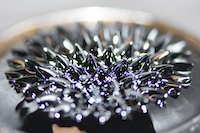
Ferrofluid dome over a magnet. Credit: Azar Eslam-Panah and Heidi Reuter.
Download Image
Flow Visualization Meets Virtual Learning
Teaching visual art usually demands hand-on experimentation, live collaboration, and physical materials. How do you do it virtually? The Pennsylvania State University’s Azar Eslam-Panah and Heidi Reuter discuss useful practices from an online art-science General Education course they developed. In their Flow Visualization course, students from all majors explore a range of techniques for understanding and creating images of the physics of fluid flows—responsible for striking phenomena like floods, tornadoes, wildfires, and atmospheric clouds. “Despite the disparate backgrounds of the students enrolled in the course, no general differences in either the scientific or artistic quality of their images, or any pattern that relates their work to their major, could be detected,” said Eslam-Panah.
POSTER: 3:55 p.m. CST, Monday, November 23, 2020
ABSTRACT: http://meetings.aps.org/Meeting/DFD20/Session/Q01.5
CONTACT: Azar Eslam-Panah, aue10@psu.edu
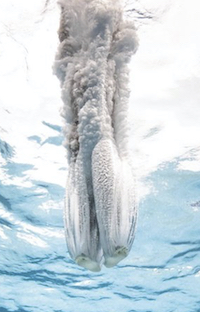
A team from LadHyX/Ecole polytechnique and MIT investigated the hydrodynamics of high diving to determine what causes injuries. Credit: Caroline Cohen.
Download Image
Dangerous Diving
Competitive divers plunge from roughly the height of a six-story building, hitting the water at 85 kilometers per hour. This violent impact can result in various bodily injuries. Caroline Cohen and a team from LadHyX/Ecole polytechnique and MIT have investigated the hydrodynamics of high diving to determine what causes injuries. They monitored dives by David Colturi, one of the world’s leading professional cliff divers, then conducted laboratory experiments to explore the underlying physics. “We study three kinds of hydrodynamic-related injury risks: the classical impact on the feet at water entry, a leg stretching phenomenon when the cavities grow on each leg, and the pressure increase when the air cavity collapses and pinches off on the diver,” said Cohen. “In particular, we show that this latter pressure increase is located on the diver's neck for a 27-meter high dive, which can turn dangerous.”
POSTER: 5:00 p.m. CST, Monday, November 23, 2020
ABSTRACT: http://meetings.aps.org/Meeting/DFD20/Session/R02.8
CONTACT: Caroline Cohen, cohen@ladhyx.polytechnique.fr
AI That Paints Like Pollock
In 3D and 4D printers, folding and coiling in the ink can derail the printing pattern. But adjustments made to prevent these deviations limit the printing technique’s speed and range. With fellow researchers from Harvard University and MIT, Guarav Chaudhary presents a system that can harness fluid folding and coiling to create specific, desired patterns. Controlled by machine learning, the new nozzle simulates writing in cursive and painting a la Jackson Pollock.
POSTER: 5:45 p.m. CST, Monday, November 23, 2020
ABSTRACT: http://meetings.aps.org/Meeting/DFD20/Session/S01.22
CONTACT: Guarav Chaudhary, gchaudhary@seas.harvard.edu
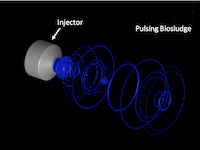
A model of an atomizer for converting human waste to energy. Credit: Daniel Wilson.
Download Image
Converting Human Waste to Energy
Injecting human waste into a conventional boiler offers a potential new source of usable energy. Daniel Wilson and Wayne Strasser of Liberty University are designing an efficient waste-to-energy conversion system that reduces water usage and fossil fuel emissions. After running computer simulations, they propose that an inverted twin-fluid atomizer will break down the biosludge most effectively. They also suggest highly concentrating the biosludge, rather than diluting or drying it. “We were surprised by how much steam usage decreased for an increase in biosludge viscosity,” said Wilson. “We have also introduced a ‘smart atomization’ model that adjusts automatically for varying biosludge properties.”
POSTER: 8:00 a.m. CST, Tuesday, November 24, 2020
ABSTRACT: http://meetings.aps.org/Meeting/DFD20/Session/T15.1
CONTACT: Daniel Wilson, dwilson221@liberty.edu
Sticky Fish
Remoras—fish that hitch rides on whales and sharks—seem to prefer certain spots on the skin of blue whales. Now researchers think they know why. An international team, led by Brooke Flammang of the New Jersey Institute of Technology (NJIT) and Rutgers University and NJIT’s Simone Marras, finds that remoras attach where flow separates and wakes form in the water just around the whale. Remoras also skim and slide along the whales wherever doing so reduces drag.
POSTER: 8:45 a.m. CST, Tuesday, November 24, 2020
ABSTRACT: http://meetings.aps.org/Meeting/DFD20/Session/U01.4
CONTACT: Brooke Flammang, flammang@g.harvard.edu
Capturing Stressed Dolphin Breath
When breathing, dolphins spew hormone-filled mucus that marine biologists analyze to determine just how stressed the animals are. Eric Abele and other Oklahoma State University researchers simulate a new device that can collect samples of dolphin breath even when no humans are present. An unmanned aerial vehicle flying through the air with a petri dish could capture a sample from a dolphin’s blowhole in under half a second.
POSTER: 10:00 a.m. CST, Tuesday, November 24, 2020
ABSTRACT: http://meetings.aps.org/Meeting/DFD20/Session/W04.8
CONTACT: Eric Abele, erabele@okstate.edu and Kerrick Ray, kerrick.ray@okstate.edu
The Sound of Disease
Certain mosquitoes can transmit deadly pathogens among humans including Plasmodium parasites which cause malaria as well as viruses such as Zika, leading to deaths of more than half a million people every year. Eastern equine encephalitis (EEE) and West Nile virus (WNV) are the latest mosquito-borne threats to appear in the northeastern United States. Rozhin Hajian and fellow researchers from Harvard University and Stanford University have used artificial intelligence to begin to tell different mosquito species apart—based on the noises their wings make. They trained a deep learning algorithm on mosquito wingbeats recorded in a laboratory. “If we succeed in identifying mosquitoes based on their sound, we can distinguish disease-carrying mosquitoes and build a warning device to alert people about the existence of such mosquitoes in the vicinity, which would save many lives yearly,” said Hajian.
POSTER: 10:45 a.m. CST, Tuesday, November 24, 2020
ABSTRACT: http://meetings.aps.org/Meeting/DFD20/Session/X02.9
CONTACT: Rozhin Hajian, hajian@seas.harvard.edu
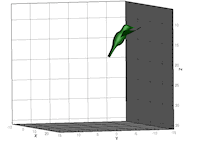
A reconstructed hummingbird escape. Credit: Haoxiang Luo.
Download Image
A High-Speed Hummingbird Escape
Startle a hummingbird, and it flies away in about one 10th of a second. New computational simulations reveal how the birds achieve this high-speed escape maneuver. The birds change their flapping pattern enough to power turning and acceleration, even while flipped upside down. “What surprised us is that the hummingbird wing motion is so complex and exquisite that while flying away, the wings can produce the necessary force/torque mechanism for the escape without losing too much lift in air,” said Haoxiang Luo, who led the modeling effort by a team from Vanderbilt University, the Pennsylvania State University, and the University of Montana. “This new knowledge will help us understand how nature’s master flyer, the hummingbird, can achieve such superb agility in air.”
POSTER: 10:45 a.m. CST, Tuesday, November 24, 2020
ABSTRACT: http://meetings.aps.org/Meeting/DFD20/Session/X02.1
CONTACT: Haoxiang Luo, haoxiang.luo@vanderbilt.edu
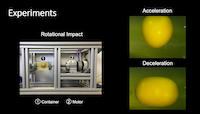
Egg yolks deform the most after decelerating rotational impacts. Credit: Ji Lang.
Download Image
Breaking Eggs and Heads
In concussions, the brain—a soft capsule bathed in liquid and surrounded by the hard shell of the skull—receives a sudden external impact. Qianhong Wu, with colleagues from Villanova University and Pennsylvania State University Berks, investigate a similar set-up: an egg. They find that egg yolks deform the most after decelerating rotational impacts. Pressure distribution, centrifugal force, and membrane shape play key roles in deforming the yolk. “The study will improve the understanding of the fundamental mechanisms involved in the incidence and mitigation of brain injury, providing critical insights about head protection mechanisms,” said researcher Ji Lang.
POSTER: 10:45 a.m. CST, Tuesday, November 24, 2020
ABSTRACT: http://meetings.aps.org/Meeting/DFD20/Session/X01.1
CONTACT: Qianhong Wu, qianhong.wu@villanova.edu and Ji Lang, jlang8@villanova.edu
Media Contact
David Barnstone
Head of Public Relations
(301) 209-3267
barnstone@aps.org
Useful Links
Complimentary registration is available to credentialed media for the express purpose of gathering and reporting news and information from the meeting. If you have not previously obtained APS press credentials (i.e. attended other APS meetings as press or receive the APS journals tip sheet), please submit a request at http://info.aps.org/press.
About DFD
The Division of Fluid Dynamics of the American Physical Society, established in 1947, exists for the advancement and diffusion of knowledge of the physics of fluids with special emphasis on the dynamical theories of the liquid, plastic, and gaseous states of matter under all conditions of temperature and pressure.
About APS
The American Physical Society (APS) is a nonprofit membership organization working to advance and diffuse the knowledge of physics through its outstanding research journals, scientific meetings, and education, outreach, advocacy, and international activities. APS represents over 55,000 members, including physicists in academia, national laboratories, and industry in the United States and throughout the world. Society offices are located in College Park, Maryland (Headquarters), Ridge, New York, and Washington, DC.
